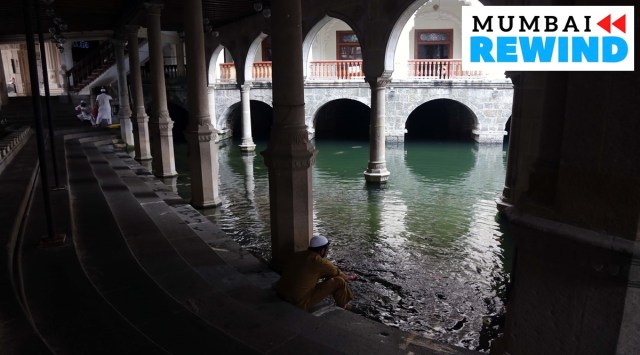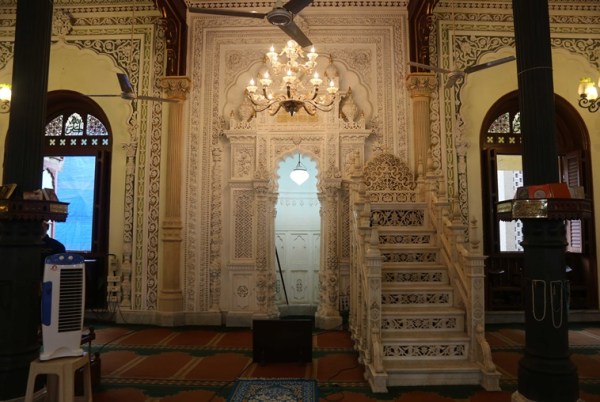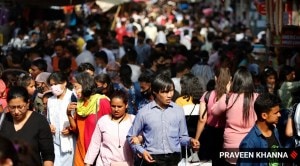- India
- International
Mumbai Rewind: Built on a water body, Mumbai’s largest and oldest mosque
After an expansion in 1837, the Juma Masjid became one of the first two-storeyed mosques in India.
 The main gate at the mosque leads directly across an open courtyard to the ancient pond on which the mosque is built. (Express)
The main gate at the mosque leads directly across an open courtyard to the ancient pond on which the mosque is built. (Express)Most visitors who come to Zaveri Bazaar or Crawford Market in Mumbai come here in search of a bargain. But only a few of them are dimly aware of the extraordinary vitality of the arabesque architecture of Juma Masjid, one of the largest and oldest mosques in Mumbai that lies at the intersection of the city’s premier commercial streets.
In existence since 1802, the quadrangular-shaped Juma Masjid is built over a large water reservoir with the help of sixteen black stone arches which rise from the depth of the water to support its massive two-storeyed structure.
 The chandelier that lights of the mosque weighs over half a tonne. (Express)
The chandelier that lights of the mosque weighs over half a tonne. (Express)
The mosque was built as Mumbai’s principal Masjid by Konkani Muslims, a maritime mercantile community known to be one of the early settlers in erstwhile Bombay. The need for the mosque was necessitated after two previous Jama Masjids located in Dongri and one close to where the existing Chhatrapati Shivaji Maharaj Terminus stands were dismantled in the mid-18th Century by the erstwhile British administrators of the city.
As per the The Gazetteer for Bombay City and Island that was compiled by S M Edwardes in 1909, for the erstwhile British regime, it was in 1775 that the Konkani Muslim community got together with an aim to build a new Jama Masjid. A Konkani Muslim merchant named Kazi Hussain Pallavkar with trading links to places like Goa and Calicut offered his land. The caveat, however, was that the large water reservoir should be preserved for perpetuity.
Patrons of the Masjid claim that various architects, including Britishers, were asked to submit designs for the proposed mosque. An architect named Mehr Ali was then selected to construct the structure on the lake. The complexity of the design and a legal wrangle meant that the construction stretched on for a good 27 years. The first congregational Friday prayers were held in December 1802 and the one-storey masjid that had been built on a water body and looked as if it floated on water was allegorically named as Jahaz-i- Akhirat or the ‘The Ship of Hereafter’.

 The pond is furnished with masonry steps and embankments, and contain more than ten feet of water fed by springs at the bottom. This water which is used for ablutions before offering prayers. (Express)
The pond is furnished with masonry steps and embankments, and contain more than ten feet of water fed by springs at the bottom. This water which is used for ablutions before offering prayers. (Express)
As the population of erstwhile Bombay grew, the need for an expansion was felt and in 1837, Mohammad Ali Mohammad Hussain Roghay offered to fund the renovation and extension of the masjid.
Upon completion, it became one of the first two-storeyed mosques in India. The highpoint of the renovation, however, was the sprawling long-span column free congregation room and a gravity defying roof full of intricate curvilinear motifs.
The entire roof is held in place by no more than a dozen pillars and scissor-like trusses hidden from view that hold the roof in place.
Over the years, the masjid has had multiple additions, including an intricately-carved marble pulpit which weighs more than a tonne. Its 15 feet-high almirahs carved from teak wood bristle out from its walls while a massive half a tonne chandelier provides lighting for the sprawling space.
The mosque is also home to a library which contains over 15,000 rare and precious books in Arabic, Persian and Urdu languages.
 The second floor of the mosque contains a sprawling longspan column free congregation room and a gravity defying roof full of intricate curvilinear motifs. (Express)
The second floor of the mosque contains a sprawling longspan column free congregation room and a gravity defying roof full of intricate curvilinear motifs. (Express)
Aware of its rich cultural and architectural value, the trustees of the mosque say that it needs to be recognised as one of Mumbai’s important public monuments open for all irrespective of religious affiliations. The trustees of the mosque have held several interactions where people across faiths have been invited to see the interiors of the mosque.
“In Islam, a mosque is so much more than just a place of worship. It is also a place to participate in the social and cultural life of the community. We are open to everyone and people are free to come and visit this place. This is one way of healing the fissures that we are witnessing as a society in today’s times,” Shoaib Khatib, trustee and chairperson of the Juma Masjid of Bombay Trust said.
Must Read
Apr 19: Latest News
- 01
- 02
- 03
- 04
- 05






































